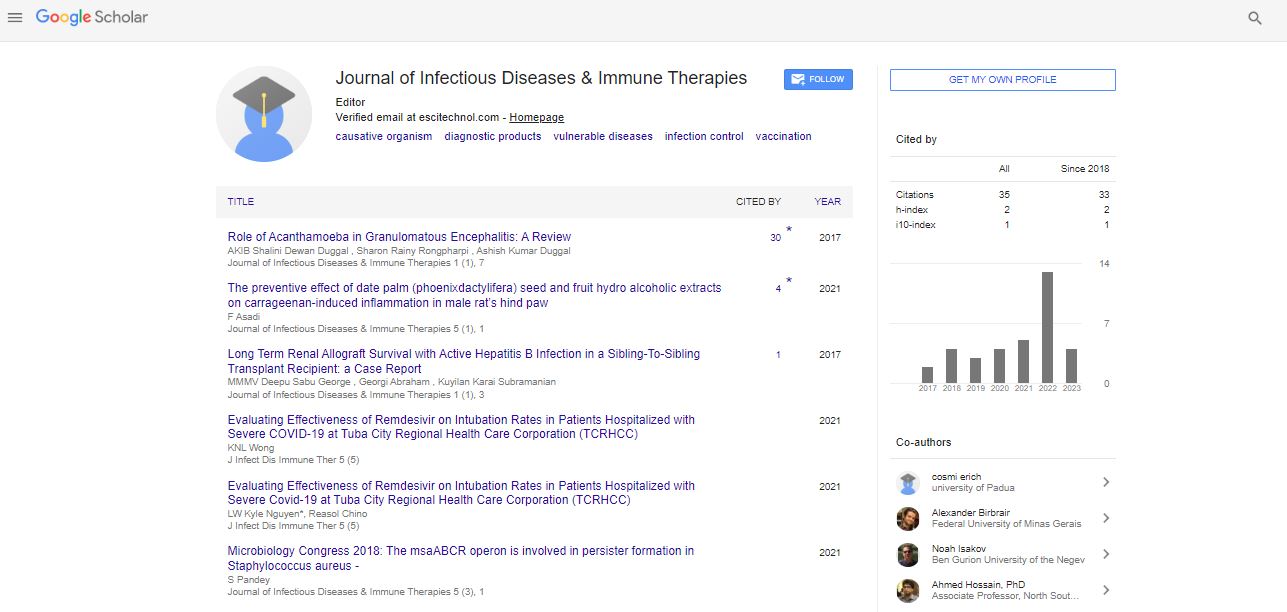Opinion Article, Vol: 12 Issue: 2
Tuberculosis Infections: Understanding the Disease, Symptoms, Treatment, and Prevention
Maximilian gareth*
Department of Pathology and Laboratory Medicine, The University of Texas Health Science Center, Houston, USA
*Corresponding Author: Maximilian gareth
Department of Pathology and
Laboratory Medicine, The University of Texas Health Science Center, Houston,
USA
E-mail: maximilian.Greathg@uth.tmc.edu
Received date: 27 May, 2023, Manuscript No. JIDITH-23-106358;
Editor assigned date: 29 May, 2023, Pre QC No. JIDITH-23-106358 (PQ);
Reviewed date: 15 June, 2023, QC No. JIDITH-23-106358;
Revised date: 23 June, 2023, Manuscript No. JIDITH-23-106358(R);
Published date: 30 June, 2023, DOI: 10.4172/2329-9541.1000346
Citation: Gareth M (2023) Tuberculosis Infections: Understanding the Disease, Symptoms, Treatment, and Prevention. J Immunol Tech Infect Dis 12:2.
Description
Tuberculosis is a highly infectious disease caused by the bacteria Mycobacterium tuberculosis. It primarily affects the lungs but can also target other organs. Despite significant progress in medical science, TB continues to be a global health concern, especially in low-and middle-income countries. In fact, according to the World Health Organization (WHO), TB is one of the top 10 causes of death worldwide. This article aims to provide a comprehensive overview of TB infections, including its causes, symptoms, diagnosis, treatment, and prevention strategies.
Tuberculosis is an airborne disease, typically spread through the inhalation of respiratory droplets from an infected person. When a person with active TB coughs, sneezes, or speaks, tiny droplets containing the bacteria can be released into the air, where they can be inhaled by others. However, not everyone exposed to the bacteria will develop the disease. Factors such as the individual's immune system, the strain of TB bacteria, and environmental conditions play a role in determining susceptibility.
The symptoms of TB can vary depending on the location and severity of the infection. Pulmonary TB, the most common form, often presents with persistent cough, chest pain, weight loss, fatigue, and night sweats. However, extrapulmonary TB can affect other organs, leading to diverse symptoms. Prompt diagnosis is crucial for effective management and prevention of further transmission. Diagnostic methods include chest X-rays, sputum tests, and molecular tests such as Polymerase Chain Reaction (PCR). In some cases, a biopsy may be necessary to confirm the diagnosis.
Treating TB requires a multidrug regimen over an extended period. The standard treatment consists of a combination of antibiotics, typically including isoniazid, rifampicin, pyrazinamide, and ethambutol. Compliance with the treatment regimen is essential to ensure complete eradication of the bacteria and to prevent the development of drug-resistant strains. Directly Observed Therapy (DOT) is a strategy often employed to enhance treatment adherence. In recent years, the emergence of drug-resistant TB, such as Multidrug- Resistant TB (MDR-TB) and Extensively Drug-Resistant TB (XDRTB), has posed additional challenges and requires specialized treatment protocols.
Preventing the spread of TB relies on a combination of strategies. Vaccination plays a crucial role, and the Bacillus Calmette-Guerin (BCG) vaccine is widely used in many countries, particularly for infants and children. However, the BCG vaccine does not offer complete protection against TB and is less effective against adult pulmonary TB. To control the disease, a comprehensive approach is necessary, including early detection and treatment of active cases, contact tracing, infection control measures, and improved living conditions.
Additionally, addressing risk factors such as poverty, malnutrition, and HIV/AIDS can significantly impact TB prevention efforts. HIVpositive individuals are particularly vulnerable to TB infection due to their weakened immune systems, making it crucial to integrate TB and HIV care services.
Tuberculosis remains a major global health concern, affecting millions of people worldwide. While progress has been made in TB prevention, diagnosis, and treatment, challenges persist, including drug resistance and inadequate healthcare infrastructure in some regions. A comprehensive approach that combines early diagnosis, effective treatment, and preventive measures is crucial for combating the disease. Global efforts to combat TB must include increased funding for research and development of new diagnostic tools and medications, as well as investments in strengthening healthcare systems. By prioritizing TB control, we can move closer to achieving the goal of a world free from tuberculosis, where everyone can live a healthy life, free from the threat of this ancient disease.
 Spanish
Spanish  Chinese
Chinese  Russian
Russian  German
German  French
French  Japanese
Japanese  Portuguese
Portuguese  Hindi
Hindi 